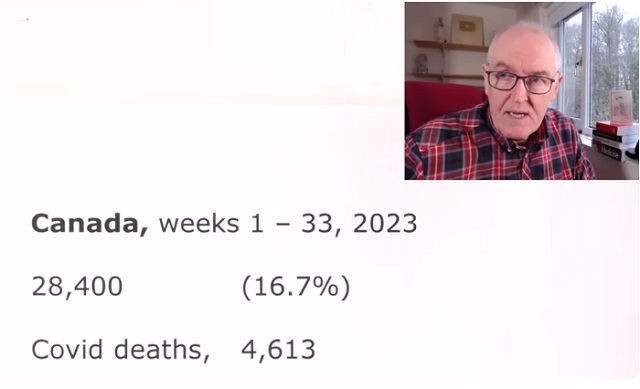COVID-19
Excess Deaths in Canada and around the world remain astoundingly high in 2023

From the YouTube channel of British health researcher Dr. John Campbell
During World War II in the UK, Germany repeatedly bombed English cities night after night for months on end. Thousands were killed. In total, though World War II, about 70,000 English civilians were killed.
In the last two years, the UK has suffered over 101,000 “excess deaths”. These are deaths that data tells us should not be expected to happen at this time. In other words, people are dying earlier than should be expected.
This isn’t only happening in the UK. The numbers are astoundingly high in Canada, Australia, the US and in most western countries with modern medical systems.
In this short video presentation Dr. John Campbells shows the numbers and asks a critical question.
Excess deaths by week, 2023 https://data-explorer.oecd.org https://stats.oecd.org/index.aspx?que…
Australia, weeks 1 – 34, 2023 14,710 (16.8%) Covid deaths, 4,977
Australia, 2022, weeks 1 – 52 29,738 (18.7%) Australia, excess deaths 2022 + 2023 = 44,448
Austria, week 1 – 44, 2023 4,444 (6.5%)
Canada, weeks 1 – 33, 2023 28,400 (16.7%) Covid deaths, 4,613
Canada, 2022 61,468 (22.3%) Canada, excess deaths 2022 + 2023 = 89,868
Denmark, weeks 1 – 44, 2023 3,052 (6.9%) Covid deaths, 347
Denmark, 2022 5,871 (11%) Denmark, excess deaths 2022 + 2023 = 8,923
Finland, weeks 1 – 44, 2023 4,627 (10.5%)
France, weeks 1 – 44, 2023 22,268 (4.9%) Covid deaths, 5,565
France, 2022 71,751 (11.9%)
Germany, weeks 1 – 44, 2023 59,039 (7.7%)
Germany, 2022 134, 578 (14.9%)
Greece, weeks 1 – 44, 2023 5,132 (5.2%)
Iceland, weeks 1 – 44, 2023 209 (11.5%) Covid deaths, 0
Iceland, 2022 446 (20.2%)
Israel, weeks 1 – 44, 2023 4,303 (11.8%) Covid deaths, 640
Israel, 2022 7,050 (15.4%)
Italy, weeks 1 – 44, 2023 938 (0.28%)
Netherlands, weeks 1 – 44, 2023 14,209 (11.3%)
Netherlands, 2022 19,326 (13.2%)
New Zealand, weeks, 1 – 44, 2023 3,960 (14.5%)
New Zealand, 2022 5,787 (17.6%)
Norway, weeks 1 – 44, 2023 1,885 (5.7%)
Norway, 2022 4,980 (12.5%)
Portugal, weeks 1 – 44, 2023 5,184 (6.3%)
Spain, weeks 1 – 44, 2023 11,948 (3.7%)
Switzerland, 1 – 44, 2023 2,063 (3.9%)
UK, weeks 1 – 44, 2023 49,389 (9.44%) Covid deaths, 18,591
UK, 2022 52,514 (9.26%) UK excess deaths 2022 + 2023 = 101,903
Height of the Blitz, September 1940 to May 1941 UK civilian deaths, 40,000
Total civilian deaths for WW2, 70,000
US, weeks 1 – 37, 2023 155,763 (7.8%) Covid deaths, 76,187
US, 2022 495,749 (17.53) US excess deaths 2022 + 2023 = 651,512
Total US deaths in Vietnam war The U.S. National Archives shows that 58,220 U.S. soldiers perished. https://www.worldatlas.com/articles/h…
Hungary, weeks 1 – 44, 2023 -3,785 (-3.2%)
Poland, weeks 1 – 43, 2023 104 (0.13%)
Slovak republic, weeks 1 – 43, 2023 -774 (-1.54%)
Sweden, weeks 1 – 44, 2023 -529 (0.6%)
COVID, the untold story. So much more makes sense after this book and my first illuminating discussion with Dr. Craig. Get your copy in the UK here: https://www.amazon.co.uk/Expired-unto…
For friends in the US get your copy here, https://www.amazon.com/Expired-untold…
This dataset presents the latest data on All-cause death statistics Excess mortality and COVID-19 deaths, by week, for all OECD countries for which data are available. The expected number of deaths is based on the average number of deaths for the same week, (2015-19) This baseline could be considered a lower estimate of the expected number of deaths since both population growth and an ageing population would be expected to push up the number of deaths observed each year. For example, New Zealand saw its population grow by around 9% since 2015, with the number of people aged 65 and over increasing by 18%.
COVID-19
Judge denies Canadian gov’t request to take away Freedom Convoy leader’s truck

From LifeSiteNews
A judge ruled that the Ontario Court of Justice is already ‘satisfied’ with Chris Barber’s sentence and taking away his very livelihood would be ‘disproportionate.’
A Canadian judge has dismissed a demand from Canadian government lawyers to seize Freedom Convoy leader Chris Barber’s “Big Red” semi-truck.
On Friday, Ontario Court of Justice Judge Heather Perkins-McVey denied the Crown’s application seeking to forfeit Barber’s truck.
She ruled that the court is already “satisfied” with Barber’s sentence and taking away his very livelihood would be “disproportionate.”
“This truck is my livelihood,” said Barber in a press release sent to LifeSiteNews.
“Trying to permanently seize it for peacefully protesting was wrong, and I’m relieved the court refused to allow that to happen,” he added.
Criminal defense lawyer Marwa Racha Younes was welcoming of the ruling as well, stating, “We find it was the right decision in the circumstances and are happy with the outcome.”
John Carpay, president of the Justice Centre for Constitutional Freedoms (JCCF), said the decision is “good news for all Canadians who cherish their Charter freedom to assemble peacefully.”
READ: Freedom Convoy protester appeals after judge dismissed challenge to frozen bank accounts
“Asset forfeiture is an extraordinary power, and it must not be used to punish Canadians for participating in peaceful protest,” he added in the press release.
As reported recently by LifeSiteNews, the Canadian government claimed that Barber’s truck is an “offence-related property” relating to his involvement in the 2022 protests against Canada’s COVID mandates.
At this time, the court ruling ends any forfeiture proceedings for the time being, however Barber will continue to try and appeal his criminal conviction and house arrest sentence.
Barber’s truck, a 2004 Kenworth long-haul he uses for business, was a focal point in the 2022 protests. He drove it to Ottawa, where it was parked for an extended period of time, but he complied when officials asked him to move it.
On October 7, 2025, after a long trial, Ontario Court Justice Perkins-McVey sentenced Barber and Tamara Lich, the other Freedom Convoy leader, to 18 months’ house arrest. They had been declared guilty of mischief for their roles as leaders of the 2022 protest against COVID mandates, and as social media influencers.
Lich and Barber have filed appeals of their own against their house arrest sentences, arguing that the trial judge did not correctly apply the law on their mischief charges.
Government lawyers for the Crown have filed an appeal of the acquittals of Lich and Barber on intimidation charges.
The pair’s convictions came after a nearly two-year trial despite the nonviolent nature of the popular movement.
COVID-19
Freedom Convoy protester appeals after judge dismissed challenge to frozen bank accounts

From LifeSiteNews
Protestor Evan Blackman’s legal team argues Trudeau’s Emergencies Act-based bank account freezes were punitive state action tied directly to protest participation.
A Freedom Convoy protester whose bank accounts were frozen by the Canadian government says a judge erred after his ruling did not consider the fact that the funds were frozen under the Emergencies Act, as grounds for a stay of proceedings.
In a press release sent out earlier this week, the Justice Centre for Constitutional Freedoms (JCCF) said that Freedom Convoy protestor Evan Blackman will challenge a court ruling in his criminal case via an appeal with the Ontario Superior Court of Justice.
“This case raises serious questions about how peaceful protest is treated in Canada and about the lasting consequences of the federal government’s unlawful use of the Emergencies Act,” noted constitutional lawyer Chris Fleury. “The freezing of protestors’ bank accounts was part of a coordinated effort to suppress dissent, and courts ought to be willing to scrutinize that conduct.”
Blackman was arrested on February 18, 2022, during the police crackdown on Freedom Convoy protests against COVID restrictions, which was authorized by the Emergencies Act (EA). The EA was put in place by former Prime Minister Justin Trudeau’s Liberal government, which claimed the protests were violent, despite no evidence that this was the case.
Blackman’s three bank accounts with TD Bank were frozen due to his participation in the Freedom Convoy, following a directive ordered by Trudeau.
As reported by LifeSiteNews, in November of this year, Blackman was convicted at his retrial even though he had been acquitted at his original trial. In 2023, Blackman’s “mischief” and “obstructing police” charges were dismissed by a judge due to lack of evidence and the “poor memory of a cop regarding key details of the alleged criminal offences.”
His retrial resulted in Blackman getting a conditional discharge along with 12 months’ probation and 122 hours of community service, along with a $200 victim fine surcharge.
After this, Blackman’s application for a stay of proceedings was dismissed by the court. He had hoped to have his stay of proceedings, under section 24(1) of the Charter of Rights and Freedoms, allowed. However, the judge ruled that the freezing of his bank accounts was legally not related to his arrest, and because of this, the stay of proceedings lacked standing.
The JCCF disagreed with this ruling, noting, it “stands in contrast to a Federal Court decision finding that the government’s invocation of the Emergencies Act was unreasonable and violated Canadians’ Charter rights, including those targeted by the financial measures used against Freedom Convoy protestors.”
As of press time, a hearing date has not been scheduled.
In 2024, Federal Court Justice Richard Mosley ruled that Trudeau was “not justified” in invoking the Emergencies Act.
In early 2022, the Freedom Convoy saw thousands of Canadians from coast to coast come to Ottawa to demand an end to COVID mandates in all forms. Despite the peaceful nature of the protest, Trudeau’s federal government enacted the EA in mid-February.
After the protesters were cleared out, which was achieved through the freezing of bank accounts of those involved without a court order as well as the physical removal and arrest of demonstrators, Trudeau revoked the EA on February 23, 2022.
-

 Alberta2 days ago
Alberta2 days agoAlberta’s huge oil sands reserves dwarf U.S. shale
-

 Alberta2 days ago
Alberta2 days agoCanada’s New Green Deal
-

 Energy1 day ago
Energy1 day agoCanada’s sudden rediscovery of energy ambition has been greeted with a familiar charge: hypocrisy
-

 Business2 days ago
Business2 days agoCOP30 finally admits what resource workers already knew: prosperity and lower emissions must go hand in hand
-

 armed forces2 days ago
armed forces2 days agoOttawa’s Newly Released Defence Plan Crosses a Dangerous Line
-

 Indigenous2 days ago
Indigenous2 days agoResidential school burials controversy continues to fuel wave of church arsons, new data suggests
-

 Business1 day ago
Business1 day agoOttawa Pretends To Pivot But Keeps Spending Like Trudeau
-

 Daily Caller1 day ago
Daily Caller1 day agoParis Climate Deal Now Decade-Old Disaster






